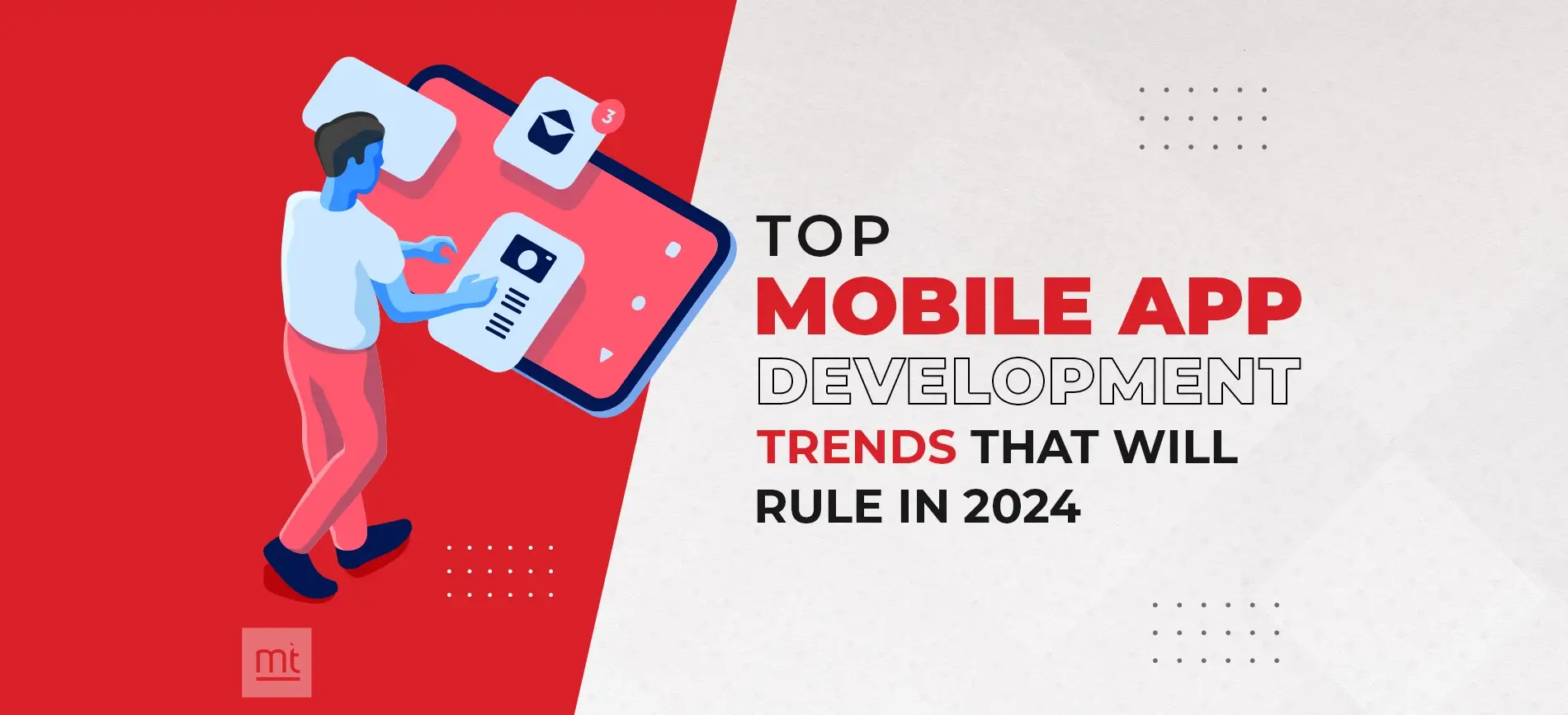Introduction:
Mobile app development is a highly critical and competitive realm. Having a mobile app can help your business outwit competition and get a niche landing in the target market.
Speed is your biggest ally in this case. If you accomplish your development goals before others, you can save the top spot for your business. Not only will speed put your business ahead, it can also ensure maximum opportunities and reduced development costs.
However, traditional development cycles may not be able to help you manage the speed you need. Too many stakeholders, lengthy cycles, fewer iterations and fragmented communication can become a pain point for the developers. It can hinder with the mobile app development process.
Only 14% Waterfall projects are successful. You need more agile and innovative processes combined with cutting-edge technologies to reduce development time and attain speed.
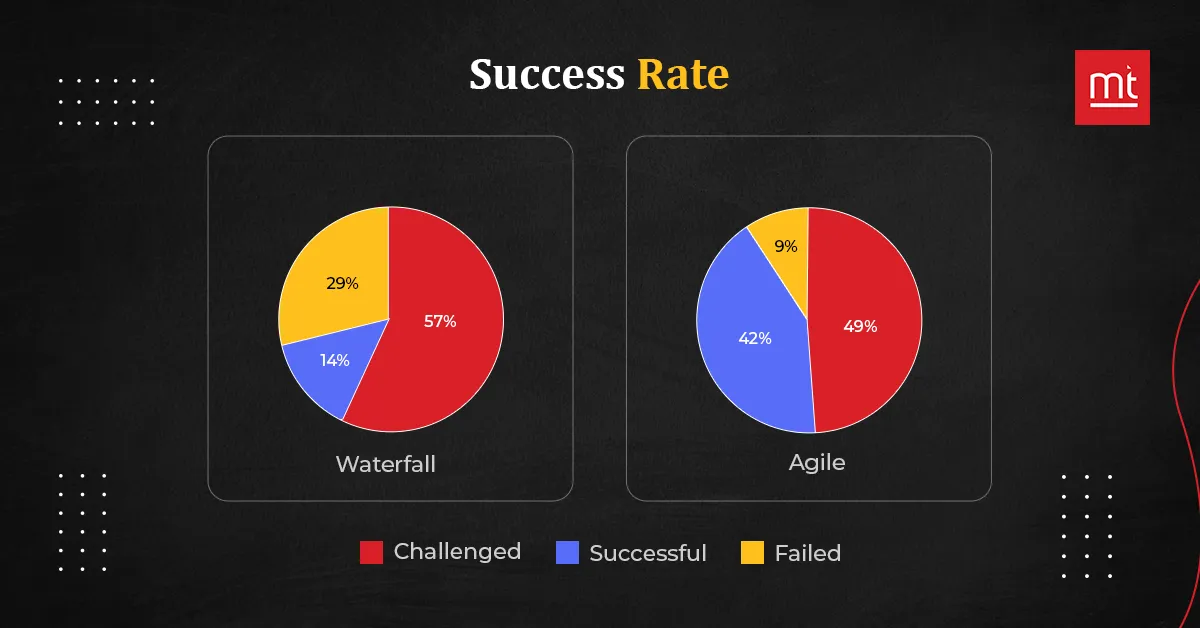
Here, we will explore all the aspects of development you must embrace to increase the development speed.
Traditional Mobile App Development Method – Five Stages
Here is a sneak peek into the mobile app development phases that you must follow.
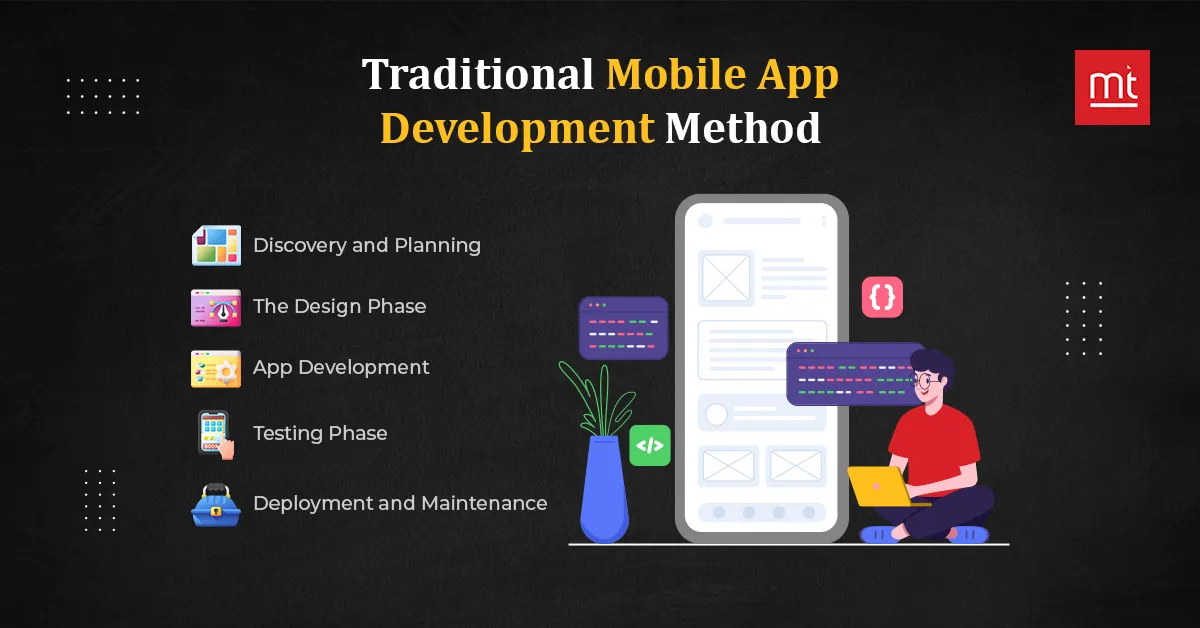
#1. Discovery and Planning
This is the first phase of development, where your team will go through requirements gathering. The team will look at the goals you have planned, your vision and the defined target market. Your team will also look at the business needs and research the market to understand the existing apps. This will help prepare the foundation for app development.
#2. The Design Phase
The design of the application is crucial for the development team. They need to focus on all aspects of the app design, including the interface and experience. The team will begin with wireframes, move on to MVP before finalizing the app design.
#3. App Development
This is the phase where your code will breathe life into the application. It is the time when your team will use technologies and frameworks to create the application.
Your teams will bring together APIs, business logic, third-party solutions and others to conclude the development. This is a lengthy part of the application development. The stakeholders cannot work in siloes in this case.
#4. Testing Phase
Once you are done with the development of the application, it is crucial to test them for performance and quality. The app should be tested for usability and functionality as well.
There are a lot of things that should be fixed before users begin using the application. It is crucial to determine the vulnerabilities and reduce the risks associated with the application.
#5. Deployment and Maintenance
This is the last phase of development, where you optimize the app and upload it to the app store. There are app store guidelines to follow, which can help you ensure releasing a bug-free app to the store.
You must also focus on maintenance along with other aspects. This is an ongoing process that involves iterating and improving the application.
Top Issues with Traditional Application Development
The traditional development method is the most often used approach to build mobile applications. This may impact the speed and cost of developing the solution.
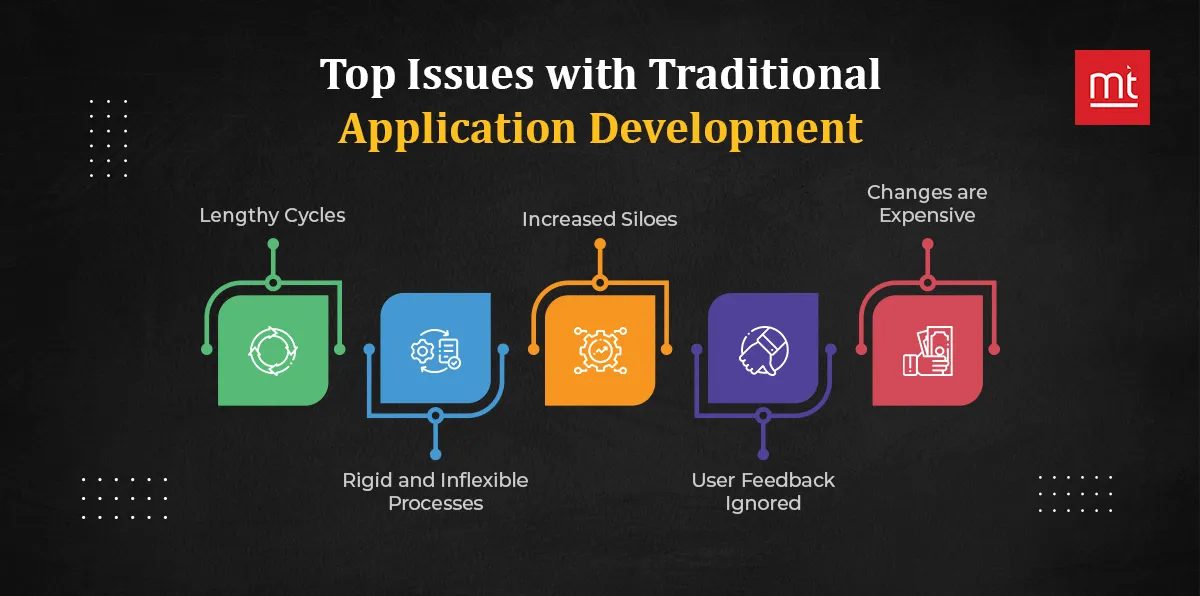
#1. Lengthy Cycles
The traditional development method uses the Waterfall method that follows a sequential progression. In this case, each stage accomplishes a goal, and then the development team moves to the next. This sequential methodology can lead to a lengthy mobile app development cycle. In case the client requests changes, they need to move through the stages again. This can increase the cycle time.
#2. Rigid and Inflexible Processes
Traditional development may lack flexibility. They cannot adapt to the changing scope or newer needs expressed by the company.
The rigidity can make it difficult for the project to evolve with your changing needs. If you want to add a new scope or need, you must follow through the entire lifecycle.
#3. Increased Siloes
When you opt for traditional development, you are encouraging siloes for the process. There is limited to no involvement from the stakeholders. This can hamper innovation. Moreover, it can also lead to misaligned expectations. Additionally, it can lead to creating a product that doesn’t meet the user’s needs.
#4. User Feedback Ignored
One of the biggest pain points with the traditional method is that the developers don’t include the feedback given. This can eventually cost you users. The user’s experience isn’t accounted for. Moreover, the product isn’t improved keeping the end user in mind.
It can also lead to issues with the usability and functionality of the application. The feedback loops are essential for a high-quality product, which goes missing in the process.
#5. Changes are Expensive
If you want to change a single aspect of the application in a traditional development approach, it can cost you a lot. You must go through time-consuming and highly expensive processes to complete the rework. There is no iteration in this process. You need to follow the entire process before you manage to finish the changes.
Top 10 Methods to Speed Up Mobile App Development Process
If you want to overcome the issues you face with the traditional mobile app development process, you must work on increasing the speed. Here are all how you can make the process faster and more efficient.
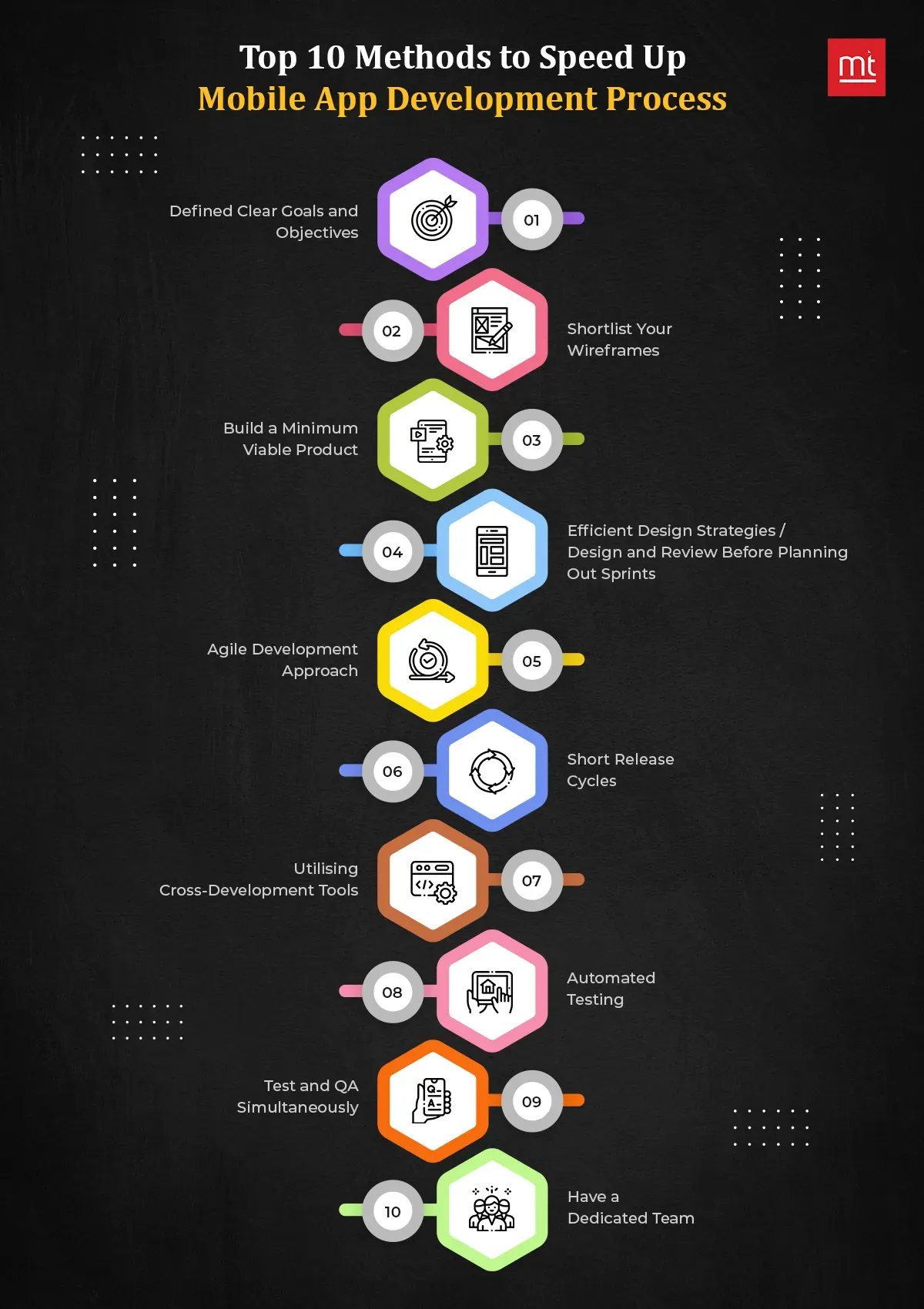
#1. Defined Clear Goals and Objectives
The foundation of a successful mobile application lies in a clear vision and defined objectives. You must be specific about the targets for the mobile application and the outcomes you aim to achieve.
The objectives can help you define the roadmap for the application development. You can do some solid market research to understand the features and functionality that lie on the priority list. It can also be used to determine user preferences and market trends for a better application.
You can also set expectations and milestones during this phase that can reduce the rework and accelerate the app development. Small goals with defining milestones can help you get the work done faster.
#2. Shortlist Your Wireframes
Wireframes are key to your minimum viable product development. They can help you focus on the right features and plan the layout perfectly. If you create several wireframes, you are showering the design team with endless possibilities.
However, if you can create a shorter list of wireframes using the factors user flow, alignment and usability, you might make the designer’s task easy.
This would also reduce the numerous iterations and ensure faster design outcomes. You can then use it to direct your app design in the right direction. It will also reduce the resource and effort costs. You are more likely to get a user-centric design by the end of this process.
#3. Build a Minimum Viable Product
A minimum viable product is a great way to get more validation from the users. You would know whether the user is ready to embrace the product. Using core features and functionality, you can gain user feedback and the response to the product.
This can help you prioritize better, simplify the processes and add feedback loops where necessary. Eventually, you will reduce the time-to-market and ensure faster development. Moreover, it helps you understand the challenges and find a way to mitigate them.
You will be working with real user data, which helps you iterate the product and launch a bug-free solution. It can also help with continuous improvement.
#4. Efficient Design Strategies / Design and review before planning out Sprints
Design strategies can help you streamline the app development process. Your design is key to getting a visually impressive and functional product.
If your strategy is picture-perfect, it can increase productivity and minimize rework. Moreover, you will notice that this helps you deliver experiential apps into the market.
You must define the critical design elements that can help with enhancing the functionality and interactions of the user. Additionally, you can also use research and data-backed insights to understand the user’s app usage preferences and design challenges. You can use these researches to create prototypes that guide your design process. Furthermore, if you foster good communication, you can enable faster and efficient design solutions.
#5. Agile development Approach
Using an agile development approach, you can create a collaborative and incremental process. This can help you create iterative cycles that help small teams deliver faster and better.
You can also use the iterative approach to deliver improved solutions and foster scalability. It can also help you adapt to the changing environments, which can reduce the scope creep.
Agile development also allows you to break down tasks into smaller and doable chunks. This helps accomplish a lot more in fewer steps. The feedback loops can ensure quicker feedback integration and faster development.
#6. Short Release Cycles
With agile development processes, you can shorten the release cycles. This would help you overcome the challenges of the traditional cycle, where even a small change has to go through a long cycle.
You can use feedback loops and iterations to make the changes and break down the process into smaller iterations. This lets you release the app or features faster as compared to the traditional development cycle.
The short release cycles could also handle the issues and challenges easily. they could help mitigate the risks associated with longer release cycles, thus making your team agile, responsive and innovative.
#7. Utilising Cross-Development Tools
If you start developing an individual app for each platform, you can take up hours of your resource time. You can reduce the time to half by using the cross-platform development tools. This allows you to create a single codebase and maintain it. you can easily reduce the resource needs and manage the time-to-market. It can also reduce the time spent on developing two separate applications.
The cross-platform applications guarantee maximum efficiency and consistency. It is cost-effective as well. Moreover, you don’t need to write the code multiple times; you can write it once and share it across platforms.
The risk of inconsistencies will also rest because of the single codebase. This also fosters speed and efficiency into the app development process.
#8. Automated Testing
Some parts of testing can be automated to increase the efficiency of the process. You can use pre-scripted tests to run repetitive tests and gain the best results. It will help you maximize test coverage while reducing the time-to-market.
You can also reduce the developer’s effort that goes into creating the test cases and running them. automated tests can ensure faster processes and reduce the errors due to manual intervention. You can detect the issues early and remove them from the system.
It is also useful in checking the application across platforms and devices. This will ensure that the app performs well across the user’s tech spectrum.
#9. Test and QA simultaneously
The simultaneous testing and quality assurance can help you detect the issues and resolve them faster. This way you can reduce the time-to-market and ensure that there is a complete alignment between developers and testers.
You can also mitigate the risks by fostering collaboration, quality and accountability. Integrating QA with testing can also help you accelerate the cycles and make them more efficient. It also helps you align the apps with the expectations.
#10. Have a dedicated team
When you have a dedicated team working on the application development, things go easier and faster. It can help you establish continuity and accountability. Moreover, there is a clearer focus among the developers and others within the team about the mobile app development timeline.
Every member is working towards a similar goal. They can manage the resources well and ensure optimal utilization. It is the dedicated team that can turn your vision into a successful application.
Why ManekTech for your mobile app developing projects?
Agility, innovation and expertise are the three pillars of a successful mobile application. We ensure adherence to all three pillars and ensure your application is aligned with your objectives.
Our agile approach makes us stand out as we release the apps faster. As your mobile app development company in the USA, we ensure that the app strategies are flexible and adaptable.
We define the scope before getting started, and make sure to do a thorough research. This allows us to create the best-fit solution for you.
Collaborative operations and seamless communication make ManekTech stand out as an ideal partner for your mobile app project.
Conclusion
Mobile app development is crucial in the ever-evolving digital realm. It is crucial to establish efficient strategies and effective processes to accomplish success. You must implement everything from cross-platform development tools to automated testing and agile development to nourish the mobile app cycles and make them faster.
It is crucial to note that the quality doesn’t suffer in the approach to drive speed. You must shorten the release cycles and be more adaptive in your approaches for successful completion.
Manektech can partner with you in this journey by offering their commitment towards your development goals. We ensure a dedicated team and strategic planning to help stand out in the mobile app market.
FAQs
1. What strategies can I employ to enhance the performance of the app?
You can use strategies such as code optimization, caching, minimization, image optimization and minimized network requests to improve app performance.
2. What is the typical timeframe for developing a mobile app?
The typical timeframe for developing a mobile app is anywhere between a few weeks and a few months. It depends on the app type, complexity and features you wish to add.
3. Can AI and machine learning hasten mobile app development?
AI and ML can help you automate the processes, mitigate the risks, improve the processes and increase user experiences.
4. How to choose a mobile app development platform?
You must use factors such as target audience, app development budget and developer skills to choose the mobile app development platform.
5. Consider these factors when choosing a mobile app development company.
You can use factors such as reviews, testimonials, experience, skills, expertise and location to find the ideal mobile app development company
About Author
Subscribe to Our Newsletter!
Join us to stay updated with our latest blog updates, marketing tips, service tips, trends, news and announcements!





